University Game Evaluation Essay: Pokemon Go Analysis and Suggestions
VerifiedAdded on 2021/06/17
|10
|2180
|124
Essay
AI Summary
This essay provides a comprehensive evaluation of the augmented reality game, Pokemon Go. It begins with an introduction to the game, outlining its features and mechanics, and then proceeds to a critical analysis of the game's design. The essay delves into relevant game theories, specifically backtracking and decision trees, and explains how these theories are applied within Pokemon Go. Furthermore, the analysis includes an evaluation of the game's strengths and weaknesses, drawing on the implications of the identified game theories. Finally, the essay concludes with a set of recommendations for improving the game, such as enhancing the user interface, addressing battery drain issues, and incorporating a social networking component. The essay is a well-structured exploration of Pokemon Go, offering valuable insights into its design and potential for improvement.
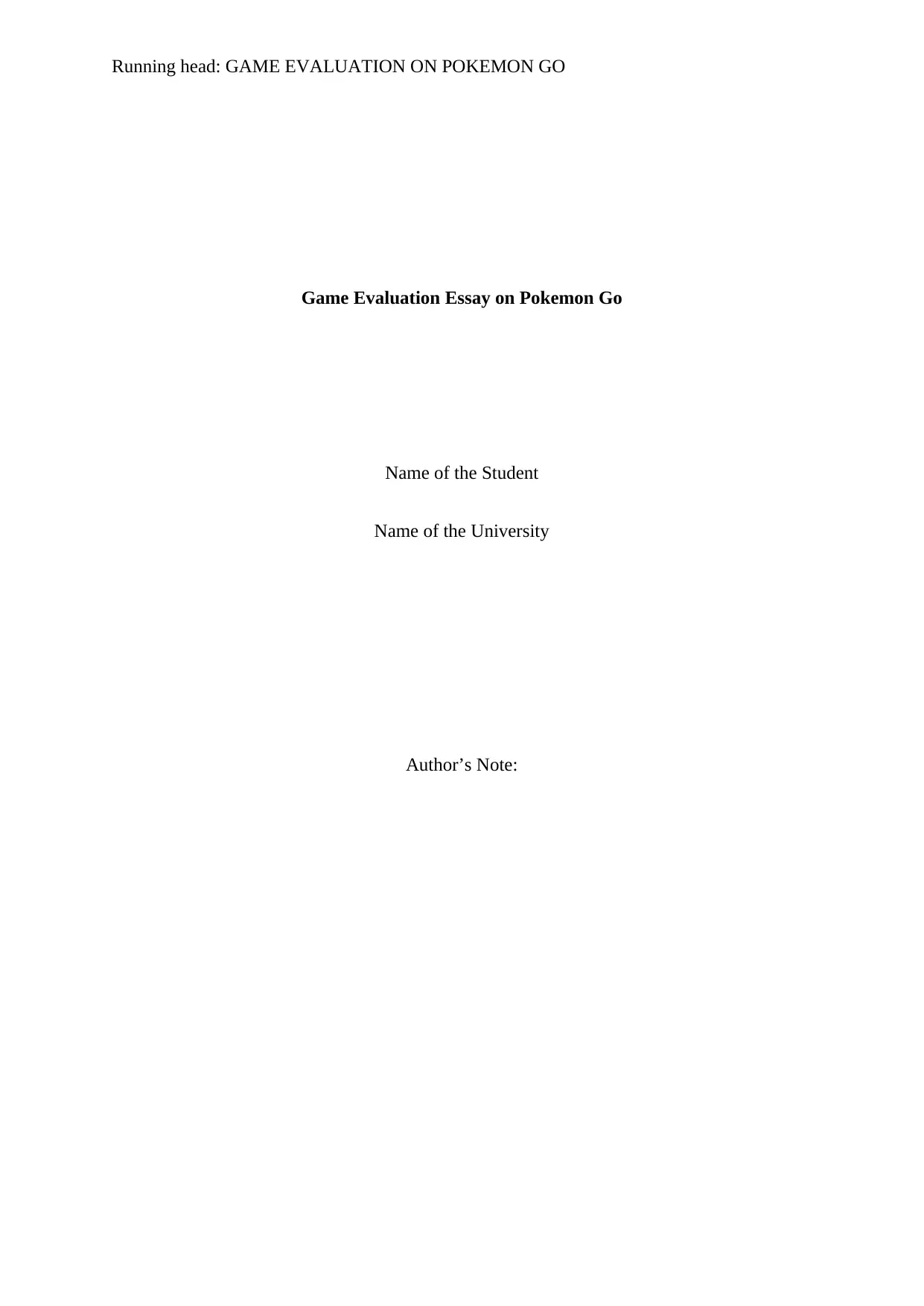
Running head: GAME EVALUATION ON POKEMON GO
Game Evaluation Essay on Pokemon Go
Name of the Student
Name of the University
Author’s Note:
Game Evaluation Essay on Pokemon Go
Name of the Student
Name of the University
Author’s Note:
Secure Best Marks with AI Grader
Need help grading? Try our AI Grader for instant feedback on your assignments.
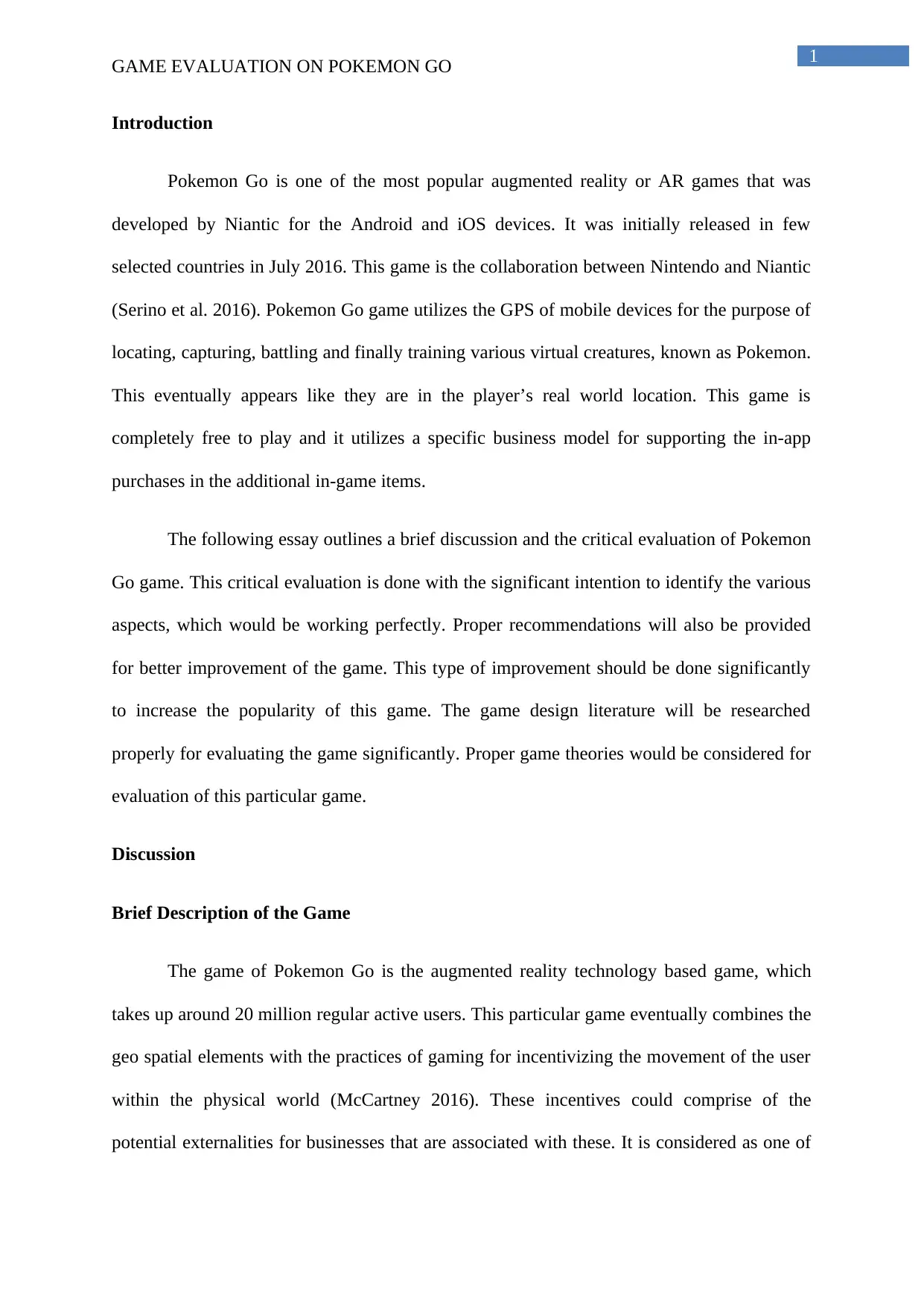
1
GAME EVALUATION ON POKEMON GO
Introduction
Pokemon Go is one of the most popular augmented reality or AR games that was
developed by Niantic for the Android and iOS devices. It was initially released in few
selected countries in July 2016. This game is the collaboration between Nintendo and Niantic
(Serino et al. 2016). Pokemon Go game utilizes the GPS of mobile devices for the purpose of
locating, capturing, battling and finally training various virtual creatures, known as Pokemon.
This eventually appears like they are in the player’s real world location. This game is
completely free to play and it utilizes a specific business model for supporting the in-app
purchases in the additional in-game items.
The following essay outlines a brief discussion and the critical evaluation of Pokemon
Go game. This critical evaluation is done with the significant intention to identify the various
aspects, which would be working perfectly. Proper recommendations will also be provided
for better improvement of the game. This type of improvement should be done significantly
to increase the popularity of this game. The game design literature will be researched
properly for evaluating the game significantly. Proper game theories would be considered for
evaluation of this particular game.
Discussion
Brief Description of the Game
The game of Pokemon Go is the augmented reality technology based game, which
takes up around 20 million regular active users. This particular game eventually combines the
geo spatial elements with the practices of gaming for incentivizing the movement of the user
within the physical world (McCartney 2016). These incentives could comprise of the
potential externalities for businesses that are associated with these. It is considered as one of
GAME EVALUATION ON POKEMON GO
Introduction
Pokemon Go is one of the most popular augmented reality or AR games that was
developed by Niantic for the Android and iOS devices. It was initially released in few
selected countries in July 2016. This game is the collaboration between Nintendo and Niantic
(Serino et al. 2016). Pokemon Go game utilizes the GPS of mobile devices for the purpose of
locating, capturing, battling and finally training various virtual creatures, known as Pokemon.
This eventually appears like they are in the player’s real world location. This game is
completely free to play and it utilizes a specific business model for supporting the in-app
purchases in the additional in-game items.
The following essay outlines a brief discussion and the critical evaluation of Pokemon
Go game. This critical evaluation is done with the significant intention to identify the various
aspects, which would be working perfectly. Proper recommendations will also be provided
for better improvement of the game. This type of improvement should be done significantly
to increase the popularity of this game. The game design literature will be researched
properly for evaluating the game significantly. Proper game theories would be considered for
evaluation of this particular game.
Discussion
Brief Description of the Game
The game of Pokemon Go is the augmented reality technology based game, which
takes up around 20 million regular active users. This particular game eventually combines the
geo spatial elements with the practices of gaming for incentivizing the movement of the user
within the physical world (McCartney 2016). These incentives could comprise of the
potential externalities for businesses that are associated with these. It is considered as one of
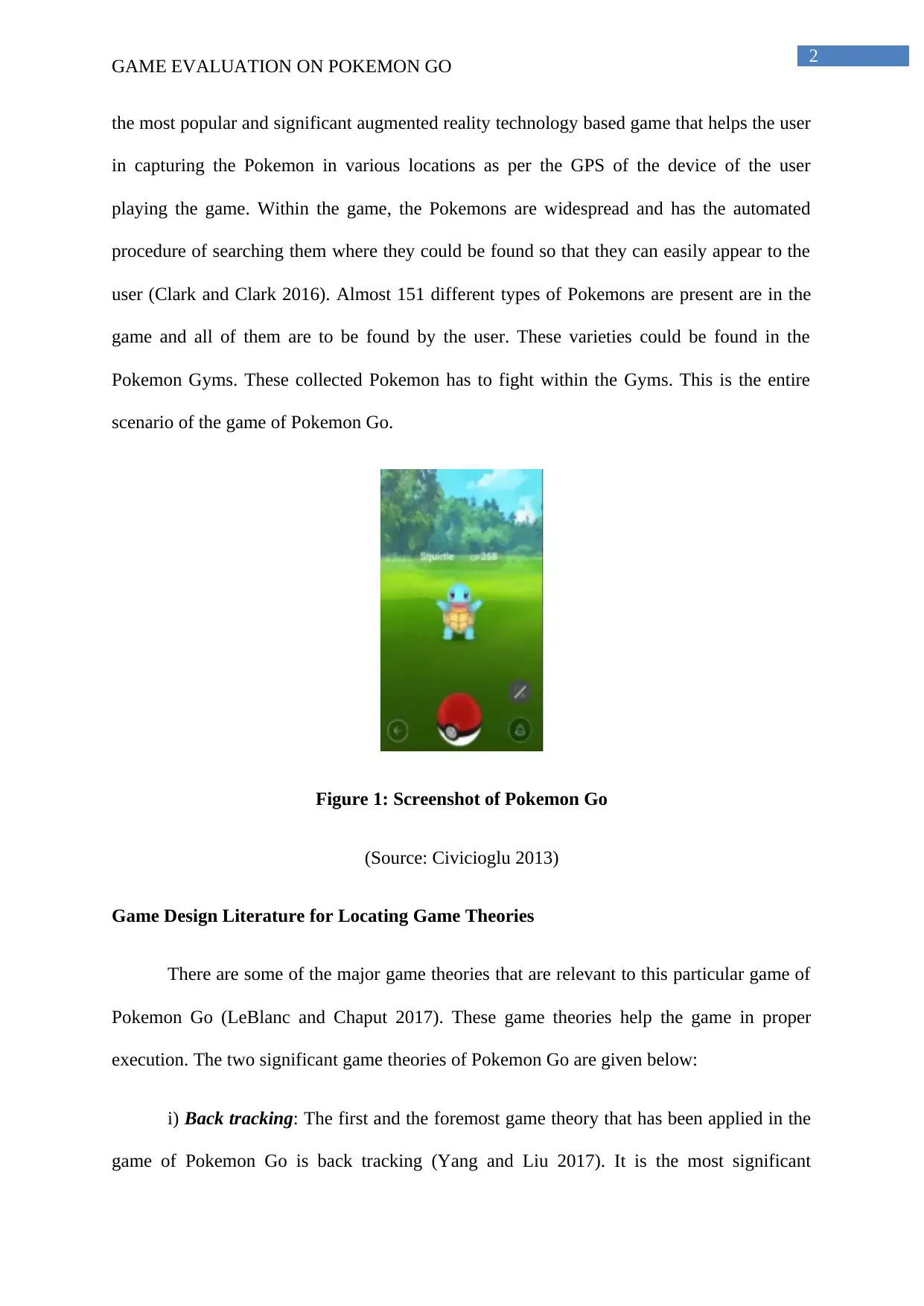
2
GAME EVALUATION ON POKEMON GO
the most popular and significant augmented reality technology based game that helps the user
in capturing the Pokemon in various locations as per the GPS of the device of the user
playing the game. Within the game, the Pokemons are widespread and has the automated
procedure of searching them where they could be found so that they can easily appear to the
user (Clark and Clark 2016). Almost 151 different types of Pokemons are present are in the
game and all of them are to be found by the user. These varieties could be found in the
Pokemon Gyms. These collected Pokemon has to fight within the Gyms. This is the entire
scenario of the game of Pokemon Go.
Figure 1: Screenshot of Pokemon Go
(Source: Civicioglu 2013)
Game Design Literature for Locating Game Theories
There are some of the major game theories that are relevant to this particular game of
Pokemon Go (LeBlanc and Chaput 2017). These game theories help the game in proper
execution. The two significant game theories of Pokemon Go are given below:
i) Back tracking: The first and the foremost game theory that has been applied in the
game of Pokemon Go is back tracking (Yang and Liu 2017). It is the most significant
GAME EVALUATION ON POKEMON GO
the most popular and significant augmented reality technology based game that helps the user
in capturing the Pokemon in various locations as per the GPS of the device of the user
playing the game. Within the game, the Pokemons are widespread and has the automated
procedure of searching them where they could be found so that they can easily appear to the
user (Clark and Clark 2016). Almost 151 different types of Pokemons are present are in the
game and all of them are to be found by the user. These varieties could be found in the
Pokemon Gyms. These collected Pokemon has to fight within the Gyms. This is the entire
scenario of the game of Pokemon Go.
Figure 1: Screenshot of Pokemon Go
(Source: Civicioglu 2013)
Game Design Literature for Locating Game Theories
There are some of the major game theories that are relevant to this particular game of
Pokemon Go (LeBlanc and Chaput 2017). These game theories help the game in proper
execution. The two significant game theories of Pokemon Go are given below:
i) Back tracking: The first and the foremost game theory that has been applied in the
game of Pokemon Go is back tracking (Yang and Liu 2017). It is the most significant
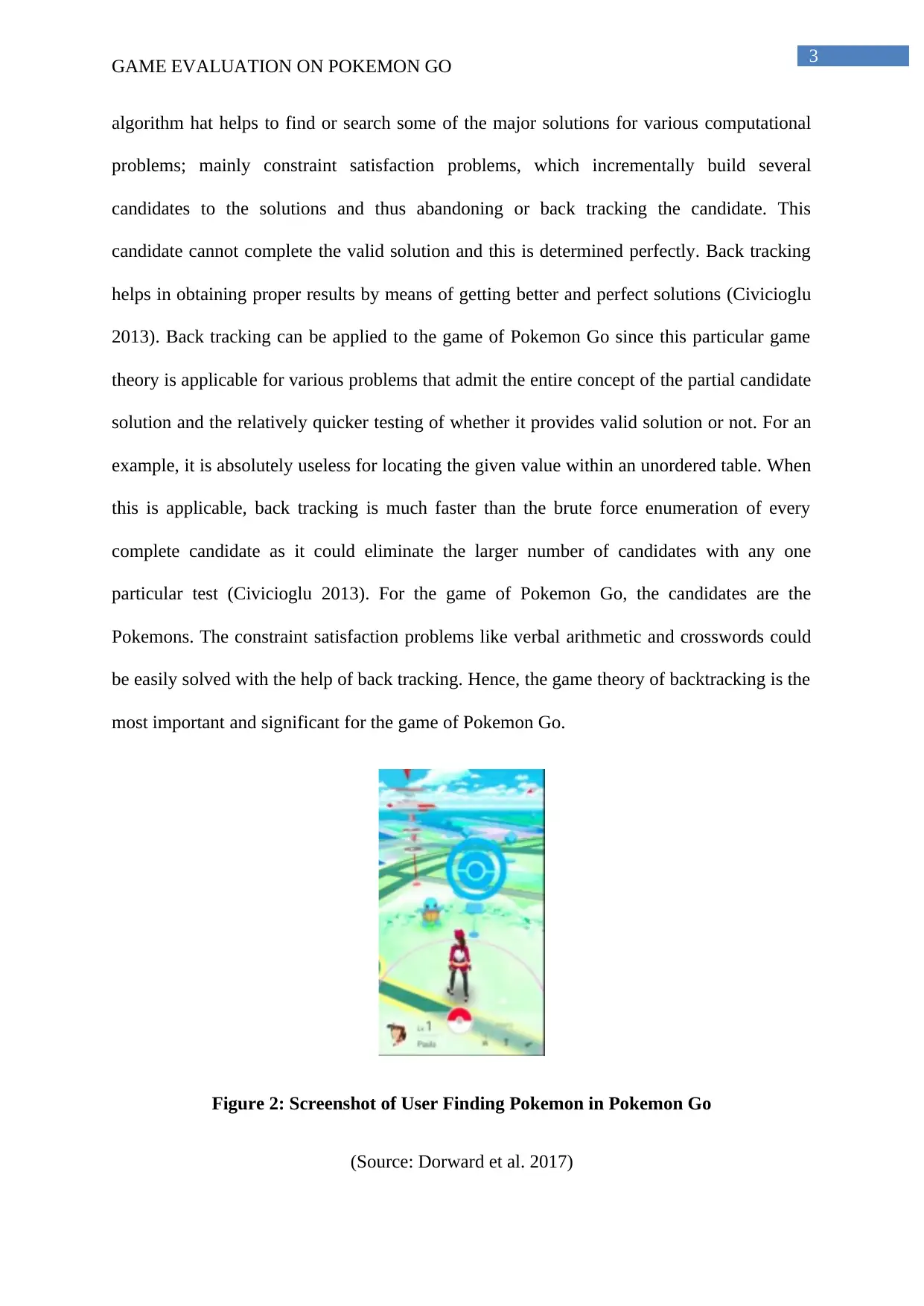
3
GAME EVALUATION ON POKEMON GO
algorithm hat helps to find or search some of the major solutions for various computational
problems; mainly constraint satisfaction problems, which incrementally build several
candidates to the solutions and thus abandoning or back tracking the candidate. This
candidate cannot complete the valid solution and this is determined perfectly. Back tracking
helps in obtaining proper results by means of getting better and perfect solutions (Civicioglu
2013). Back tracking can be applied to the game of Pokemon Go since this particular game
theory is applicable for various problems that admit the entire concept of the partial candidate
solution and the relatively quicker testing of whether it provides valid solution or not. For an
example, it is absolutely useless for locating the given value within an unordered table. When
this is applicable, back tracking is much faster than the brute force enumeration of every
complete candidate as it could eliminate the larger number of candidates with any one
particular test (Civicioglu 2013). For the game of Pokemon Go, the candidates are the
Pokemons. The constraint satisfaction problems like verbal arithmetic and crosswords could
be easily solved with the help of back tracking. Hence, the game theory of backtracking is the
most important and significant for the game of Pokemon Go.
Figure 2: Screenshot of User Finding Pokemon in Pokemon Go
(Source: Dorward et al. 2017)
GAME EVALUATION ON POKEMON GO
algorithm hat helps to find or search some of the major solutions for various computational
problems; mainly constraint satisfaction problems, which incrementally build several
candidates to the solutions and thus abandoning or back tracking the candidate. This
candidate cannot complete the valid solution and this is determined perfectly. Back tracking
helps in obtaining proper results by means of getting better and perfect solutions (Civicioglu
2013). Back tracking can be applied to the game of Pokemon Go since this particular game
theory is applicable for various problems that admit the entire concept of the partial candidate
solution and the relatively quicker testing of whether it provides valid solution or not. For an
example, it is absolutely useless for locating the given value within an unordered table. When
this is applicable, back tracking is much faster than the brute force enumeration of every
complete candidate as it could eliminate the larger number of candidates with any one
particular test (Civicioglu 2013). For the game of Pokemon Go, the candidates are the
Pokemons. The constraint satisfaction problems like verbal arithmetic and crosswords could
be easily solved with the help of back tracking. Hence, the game theory of backtracking is the
most important and significant for the game of Pokemon Go.
Figure 2: Screenshot of User Finding Pokemon in Pokemon Go
(Source: Dorward et al. 2017)
Secure Best Marks with AI Grader
Need help grading? Try our AI Grader for instant feedback on your assignments.
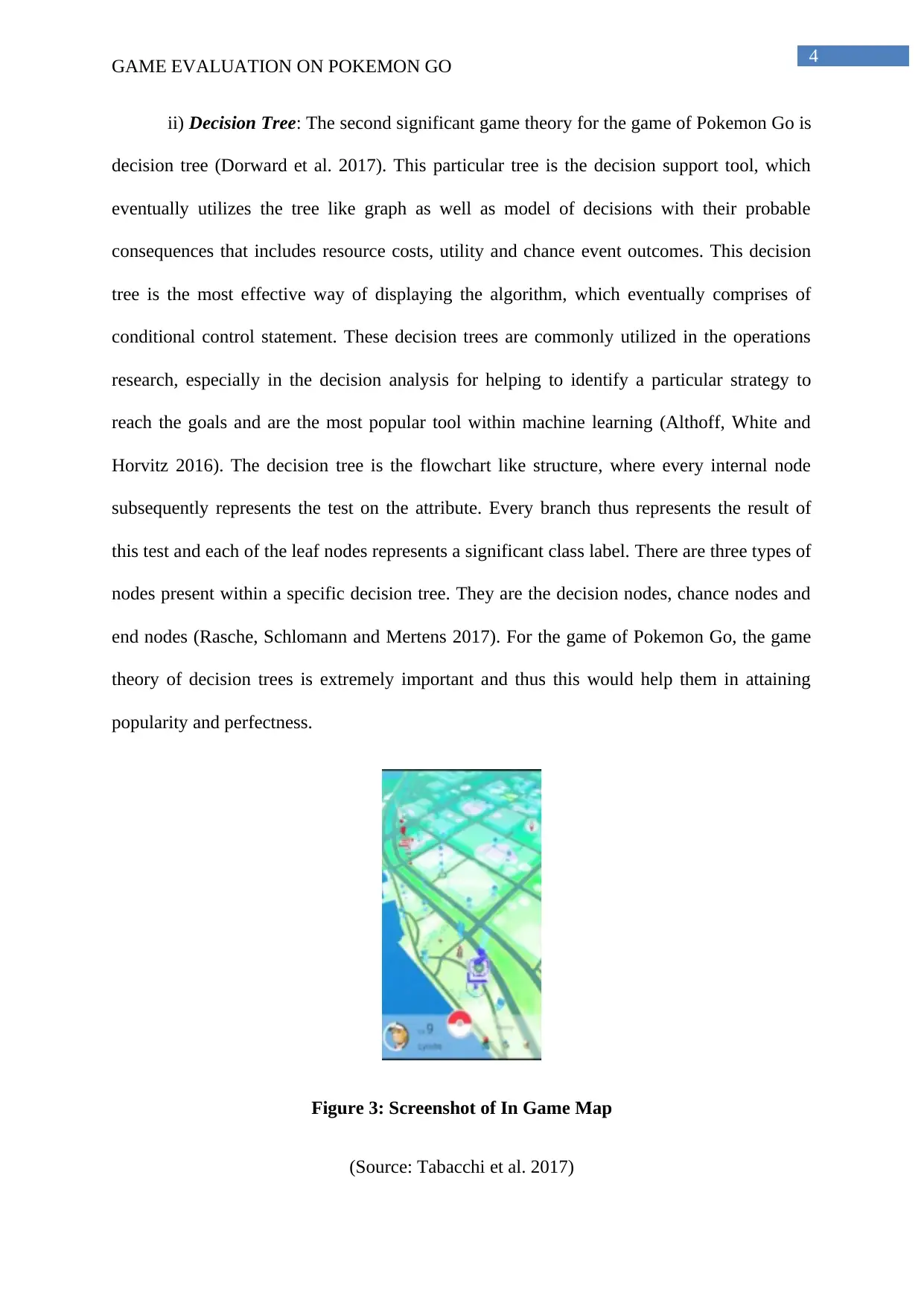
4
GAME EVALUATION ON POKEMON GO
ii) Decision Tree: The second significant game theory for the game of Pokemon Go is
decision tree (Dorward et al. 2017). This particular tree is the decision support tool, which
eventually utilizes the tree like graph as well as model of decisions with their probable
consequences that includes resource costs, utility and chance event outcomes. This decision
tree is the most effective way of displaying the algorithm, which eventually comprises of
conditional control statement. These decision trees are commonly utilized in the operations
research, especially in the decision analysis for helping to identify a particular strategy to
reach the goals and are the most popular tool within machine learning (Althoff, White and
Horvitz 2016). The decision tree is the flowchart like structure, where every internal node
subsequently represents the test on the attribute. Every branch thus represents the result of
this test and each of the leaf nodes represents a significant class label. There are three types of
nodes present within a specific decision tree. They are the decision nodes, chance nodes and
end nodes (Rasche, Schlomann and Mertens 2017). For the game of Pokemon Go, the game
theory of decision trees is extremely important and thus this would help them in attaining
popularity and perfectness.
Figure 3: Screenshot of In Game Map
(Source: Tabacchi et al. 2017)
GAME EVALUATION ON POKEMON GO
ii) Decision Tree: The second significant game theory for the game of Pokemon Go is
decision tree (Dorward et al. 2017). This particular tree is the decision support tool, which
eventually utilizes the tree like graph as well as model of decisions with their probable
consequences that includes resource costs, utility and chance event outcomes. This decision
tree is the most effective way of displaying the algorithm, which eventually comprises of
conditional control statement. These decision trees are commonly utilized in the operations
research, especially in the decision analysis for helping to identify a particular strategy to
reach the goals and are the most popular tool within machine learning (Althoff, White and
Horvitz 2016). The decision tree is the flowchart like structure, where every internal node
subsequently represents the test on the attribute. Every branch thus represents the result of
this test and each of the leaf nodes represents a significant class label. There are three types of
nodes present within a specific decision tree. They are the decision nodes, chance nodes and
end nodes (Rasche, Schlomann and Mertens 2017). For the game of Pokemon Go, the game
theory of decision trees is extremely important and thus this would help them in attaining
popularity and perfectness.
Figure 3: Screenshot of In Game Map
(Source: Tabacchi et al. 2017)
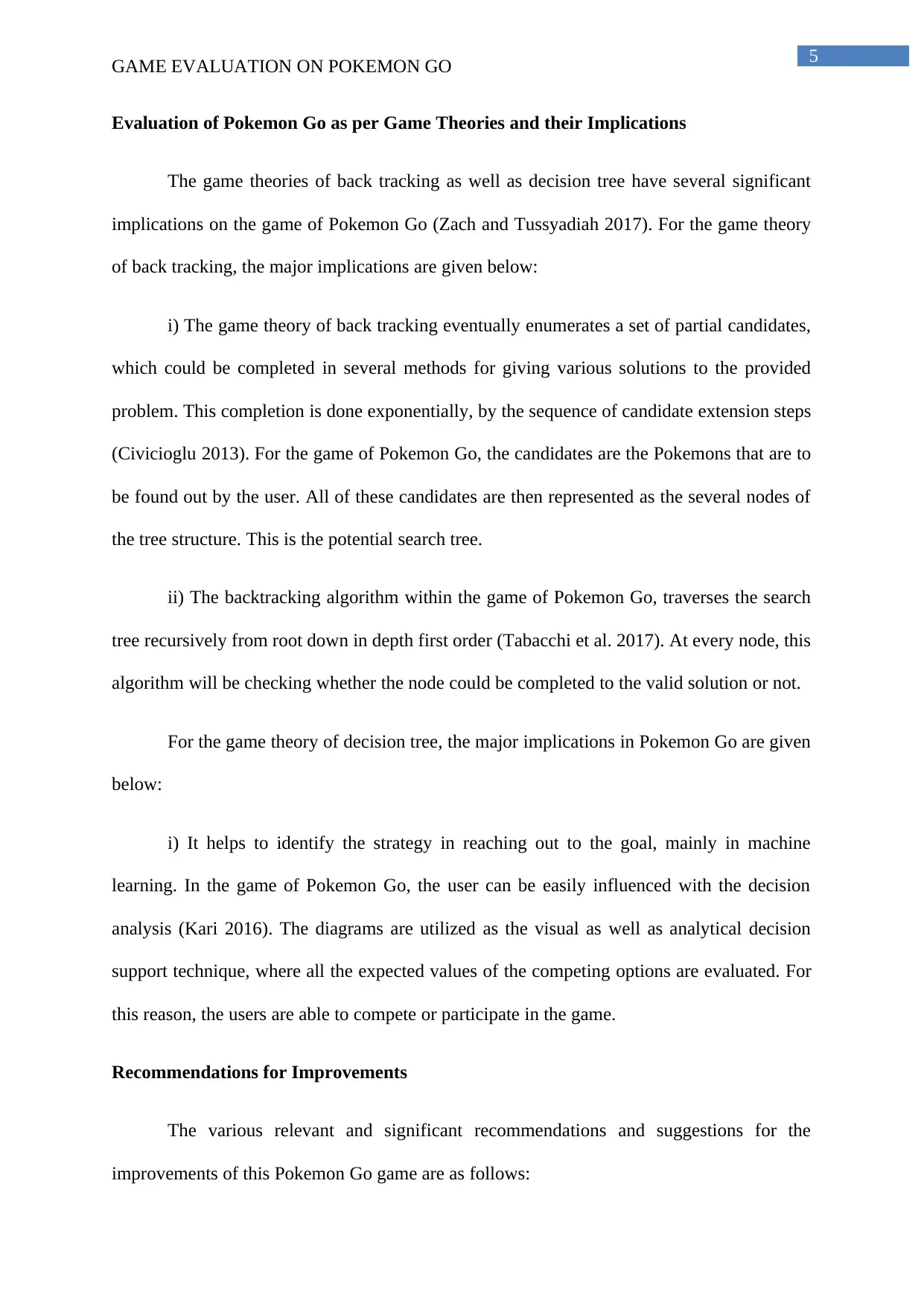
5
GAME EVALUATION ON POKEMON GO
Evaluation of Pokemon Go as per Game Theories and their Implications
The game theories of back tracking as well as decision tree have several significant
implications on the game of Pokemon Go (Zach and Tussyadiah 2017). For the game theory
of back tracking, the major implications are given below:
i) The game theory of back tracking eventually enumerates a set of partial candidates,
which could be completed in several methods for giving various solutions to the provided
problem. This completion is done exponentially, by the sequence of candidate extension steps
(Civicioglu 2013). For the game of Pokemon Go, the candidates are the Pokemons that are to
be found out by the user. All of these candidates are then represented as the several nodes of
the tree structure. This is the potential search tree.
ii) The backtracking algorithm within the game of Pokemon Go, traverses the search
tree recursively from root down in depth first order (Tabacchi et al. 2017). At every node, this
algorithm will be checking whether the node could be completed to the valid solution or not.
For the game theory of decision tree, the major implications in Pokemon Go are given
below:
i) It helps to identify the strategy in reaching out to the goal, mainly in machine
learning. In the game of Pokemon Go, the user can be easily influenced with the decision
analysis (Kari 2016). The diagrams are utilized as the visual as well as analytical decision
support technique, where all the expected values of the competing options are evaluated. For
this reason, the users are able to compete or participate in the game.
Recommendations for Improvements
The various relevant and significant recommendations and suggestions for the
improvements of this Pokemon Go game are as follows:
GAME EVALUATION ON POKEMON GO
Evaluation of Pokemon Go as per Game Theories and their Implications
The game theories of back tracking as well as decision tree have several significant
implications on the game of Pokemon Go (Zach and Tussyadiah 2017). For the game theory
of back tracking, the major implications are given below:
i) The game theory of back tracking eventually enumerates a set of partial candidates,
which could be completed in several methods for giving various solutions to the provided
problem. This completion is done exponentially, by the sequence of candidate extension steps
(Civicioglu 2013). For the game of Pokemon Go, the candidates are the Pokemons that are to
be found out by the user. All of these candidates are then represented as the several nodes of
the tree structure. This is the potential search tree.
ii) The backtracking algorithm within the game of Pokemon Go, traverses the search
tree recursively from root down in depth first order (Tabacchi et al. 2017). At every node, this
algorithm will be checking whether the node could be completed to the valid solution or not.
For the game theory of decision tree, the major implications in Pokemon Go are given
below:
i) It helps to identify the strategy in reaching out to the goal, mainly in machine
learning. In the game of Pokemon Go, the user can be easily influenced with the decision
analysis (Kari 2016). The diagrams are utilized as the visual as well as analytical decision
support technique, where all the expected values of the competing options are evaluated. For
this reason, the users are able to compete or participate in the game.
Recommendations for Improvements
The various relevant and significant recommendations and suggestions for the
improvements of this Pokemon Go game are as follows:
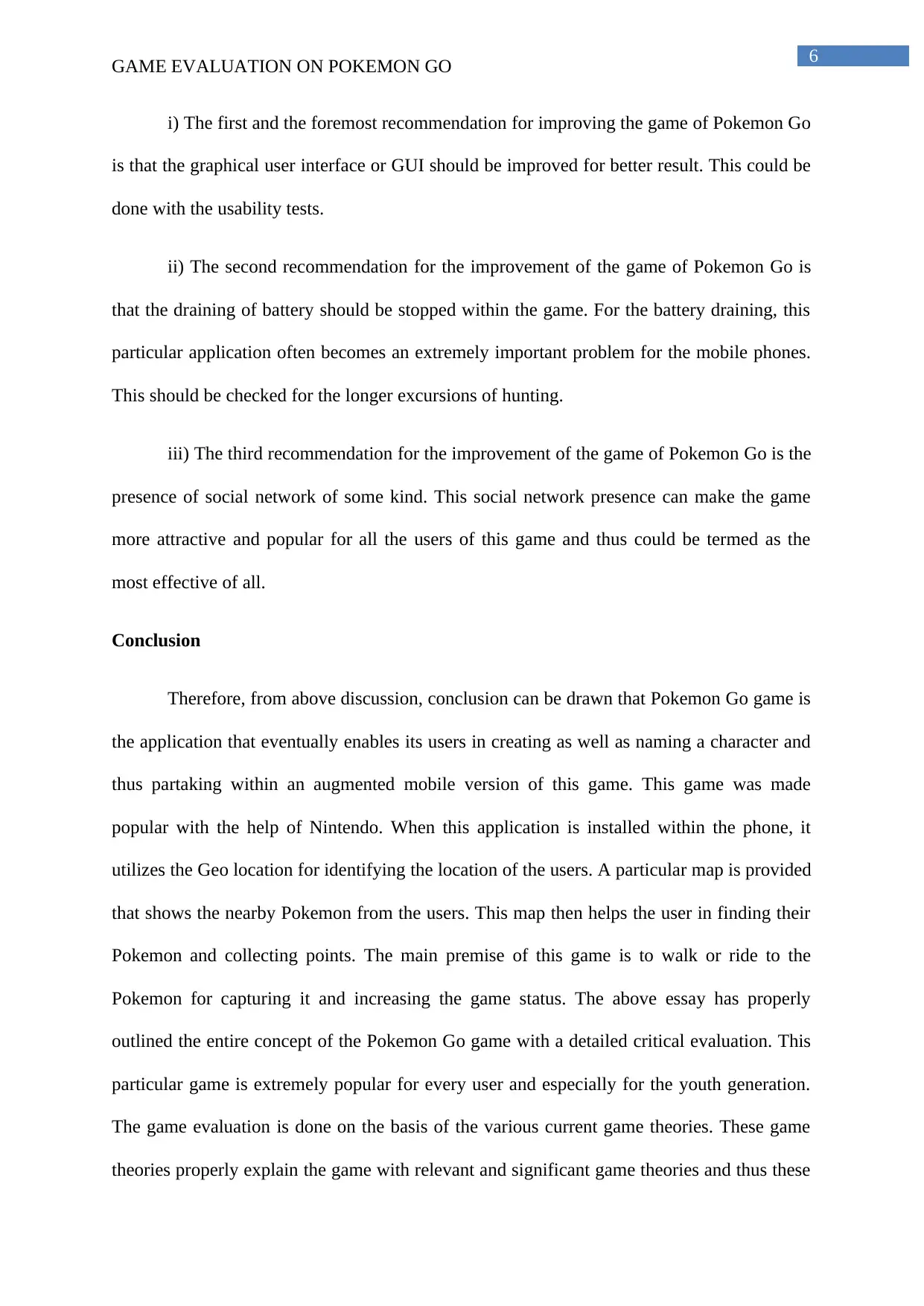
6
GAME EVALUATION ON POKEMON GO
i) The first and the foremost recommendation for improving the game of Pokemon Go
is that the graphical user interface or GUI should be improved for better result. This could be
done with the usability tests.
ii) The second recommendation for the improvement of the game of Pokemon Go is
that the draining of battery should be stopped within the game. For the battery draining, this
particular application often becomes an extremely important problem for the mobile phones.
This should be checked for the longer excursions of hunting.
iii) The third recommendation for the improvement of the game of Pokemon Go is the
presence of social network of some kind. This social network presence can make the game
more attractive and popular for all the users of this game and thus could be termed as the
most effective of all.
Conclusion
Therefore, from above discussion, conclusion can be drawn that Pokemon Go game is
the application that eventually enables its users in creating as well as naming a character and
thus partaking within an augmented mobile version of this game. This game was made
popular with the help of Nintendo. When this application is installed within the phone, it
utilizes the Geo location for identifying the location of the users. A particular map is provided
that shows the nearby Pokemon from the users. This map then helps the user in finding their
Pokemon and collecting points. The main premise of this game is to walk or ride to the
Pokemon for capturing it and increasing the game status. The above essay has properly
outlined the entire concept of the Pokemon Go game with a detailed critical evaluation. This
particular game is extremely popular for every user and especially for the youth generation.
The game evaluation is done on the basis of the various current game theories. These game
theories properly explain the game with relevant and significant game theories and thus these
GAME EVALUATION ON POKEMON GO
i) The first and the foremost recommendation for improving the game of Pokemon Go
is that the graphical user interface or GUI should be improved for better result. This could be
done with the usability tests.
ii) The second recommendation for the improvement of the game of Pokemon Go is
that the draining of battery should be stopped within the game. For the battery draining, this
particular application often becomes an extremely important problem for the mobile phones.
This should be checked for the longer excursions of hunting.
iii) The third recommendation for the improvement of the game of Pokemon Go is the
presence of social network of some kind. This social network presence can make the game
more attractive and popular for all the users of this game and thus could be termed as the
most effective of all.
Conclusion
Therefore, from above discussion, conclusion can be drawn that Pokemon Go game is
the application that eventually enables its users in creating as well as naming a character and
thus partaking within an augmented mobile version of this game. This game was made
popular with the help of Nintendo. When this application is installed within the phone, it
utilizes the Geo location for identifying the location of the users. A particular map is provided
that shows the nearby Pokemon from the users. This map then helps the user in finding their
Pokemon and collecting points. The main premise of this game is to walk or ride to the
Pokemon for capturing it and increasing the game status. The above essay has properly
outlined the entire concept of the Pokemon Go game with a detailed critical evaluation. This
particular game is extremely popular for every user and especially for the youth generation.
The game evaluation is done on the basis of the various current game theories. These game
theories properly explain the game with relevant and significant game theories and thus these
Paraphrase This Document
Need a fresh take? Get an instant paraphrase of this document with our AI Paraphraser

7
GAME EVALUATION ON POKEMON GO
theories are termed as the most relevant of all. Moreover, proper recommendations are also
provided within the essay to improve the game and make more users friendly.
GAME EVALUATION ON POKEMON GO
theories are termed as the most relevant of all. Moreover, proper recommendations are also
provided within the essay to improve the game and make more users friendly.
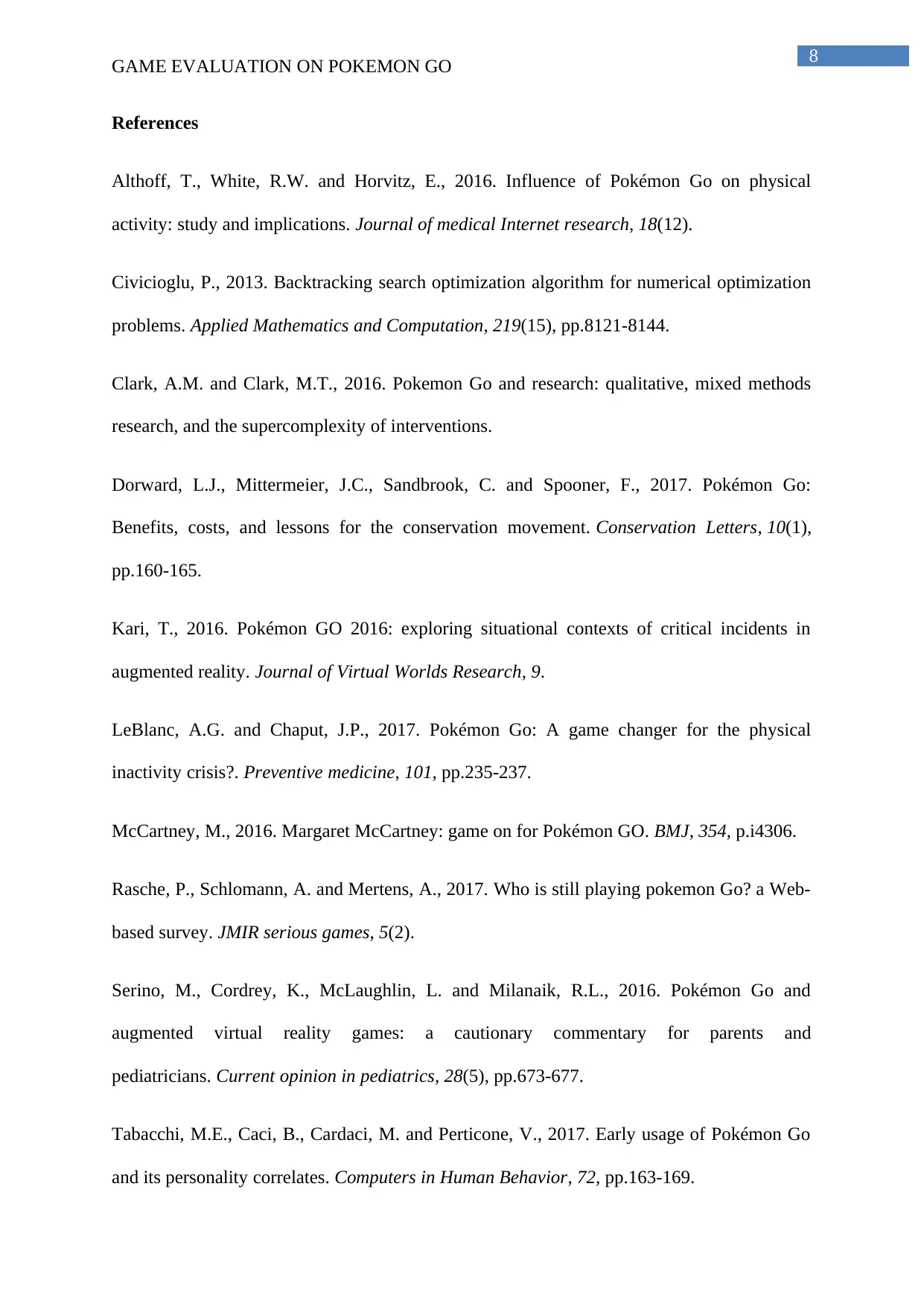
8
GAME EVALUATION ON POKEMON GO
References
Althoff, T., White, R.W. and Horvitz, E., 2016. Influence of Pokémon Go on physical
activity: study and implications. Journal of medical Internet research, 18(12).
Civicioglu, P., 2013. Backtracking search optimization algorithm for numerical optimization
problems. Applied Mathematics and Computation, 219(15), pp.8121-8144.
Clark, A.M. and Clark, M.T., 2016. Pokemon Go and research: qualitative, mixed methods
research, and the supercomplexity of interventions.
Dorward, L.J., Mittermeier, J.C., Sandbrook, C. and Spooner, F., 2017. Pokémon Go:
Benefits, costs, and lessons for the conservation movement. Conservation Letters, 10(1),
pp.160-165.
Kari, T., 2016. Pokémon GO 2016: exploring situational contexts of critical incidents in
augmented reality. Journal of Virtual Worlds Research, 9.
LeBlanc, A.G. and Chaput, J.P., 2017. Pokémon Go: A game changer for the physical
inactivity crisis?. Preventive medicine, 101, pp.235-237.
McCartney, M., 2016. Margaret McCartney: game on for Pokémon GO. BMJ, 354, p.i4306.
Rasche, P., Schlomann, A. and Mertens, A., 2017. Who is still playing pokemon Go? a Web-
based survey. JMIR serious games, 5(2).
Serino, M., Cordrey, K., McLaughlin, L. and Milanaik, R.L., 2016. Pokémon Go and
augmented virtual reality games: a cautionary commentary for parents and
pediatricians. Current opinion in pediatrics, 28(5), pp.673-677.
Tabacchi, M.E., Caci, B., Cardaci, M. and Perticone, V., 2017. Early usage of Pokémon Go
and its personality correlates. Computers in Human Behavior, 72, pp.163-169.
GAME EVALUATION ON POKEMON GO
References
Althoff, T., White, R.W. and Horvitz, E., 2016. Influence of Pokémon Go on physical
activity: study and implications. Journal of medical Internet research, 18(12).
Civicioglu, P., 2013. Backtracking search optimization algorithm for numerical optimization
problems. Applied Mathematics and Computation, 219(15), pp.8121-8144.
Clark, A.M. and Clark, M.T., 2016. Pokemon Go and research: qualitative, mixed methods
research, and the supercomplexity of interventions.
Dorward, L.J., Mittermeier, J.C., Sandbrook, C. and Spooner, F., 2017. Pokémon Go:
Benefits, costs, and lessons for the conservation movement. Conservation Letters, 10(1),
pp.160-165.
Kari, T., 2016. Pokémon GO 2016: exploring situational contexts of critical incidents in
augmented reality. Journal of Virtual Worlds Research, 9.
LeBlanc, A.G. and Chaput, J.P., 2017. Pokémon Go: A game changer for the physical
inactivity crisis?. Preventive medicine, 101, pp.235-237.
McCartney, M., 2016. Margaret McCartney: game on for Pokémon GO. BMJ, 354, p.i4306.
Rasche, P., Schlomann, A. and Mertens, A., 2017. Who is still playing pokemon Go? a Web-
based survey. JMIR serious games, 5(2).
Serino, M., Cordrey, K., McLaughlin, L. and Milanaik, R.L., 2016. Pokémon Go and
augmented virtual reality games: a cautionary commentary for parents and
pediatricians. Current opinion in pediatrics, 28(5), pp.673-677.
Tabacchi, M.E., Caci, B., Cardaci, M. and Perticone, V., 2017. Early usage of Pokémon Go
and its personality correlates. Computers in Human Behavior, 72, pp.163-169.

9
GAME EVALUATION ON POKEMON GO
Yang, C.C. and Liu, D., 2017. Motives matter: motives for playing Pokémon Go and
implications for well-being. Cyberpsychology, Behavior, and Social Networking, 20(1),
pp.52-57.
Zach, F.J. and Tussyadiah, I.P., 2017. To catch them all—the (un) intended consequences of
Pokémon GO on mobility, consumption, and wellbeing. In Information and communication
technologies in tourism 2017 (pp. 217-227). Springer, Cham.
GAME EVALUATION ON POKEMON GO
Yang, C.C. and Liu, D., 2017. Motives matter: motives for playing Pokémon Go and
implications for well-being. Cyberpsychology, Behavior, and Social Networking, 20(1),
pp.52-57.
Zach, F.J. and Tussyadiah, I.P., 2017. To catch them all—the (un) intended consequences of
Pokémon GO on mobility, consumption, and wellbeing. In Information and communication
technologies in tourism 2017 (pp. 217-227). Springer, Cham.
1 out of 10
Your All-in-One AI-Powered Toolkit for Academic Success.
+13062052269
info@desklib.com
Available 24*7 on WhatsApp / Email
![[object Object]](/_next/static/media/star-bottom.7253800d.svg)
Unlock your academic potential
© 2024 | Zucol Services PVT LTD | All rights reserved.
